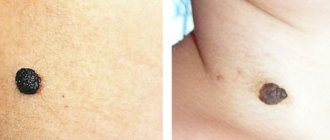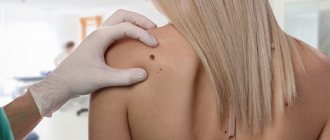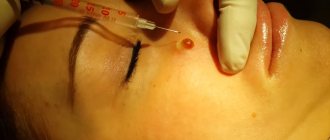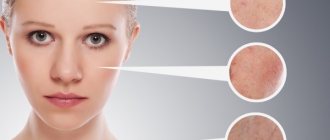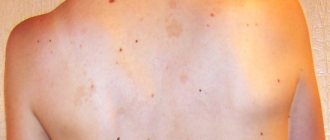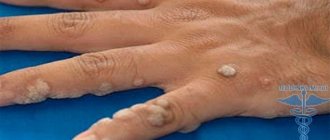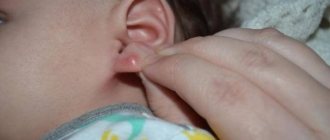Small birthmarks (nevi) usually appear during childhood or adolescence, although they are sometimes present at birth. They consist of pigmented cells - melanocytes. The formations are mostly flat, but there are also elevated ones. As a rule, round or oval of regular shape.
Usually, nevi do not change in appearance throughout life. Also, after 40 years, new pigmentation very rarely occurs. But sometimes a person as an adult begins to notice that a mole is growing . This situation should not be ignored, since the emergence of a new or rapid growth of an old nevus can be the main sign of the development of skin cancer (melanoma).
Reasons for growth
If a mole has increased significantly in size, this could be influenced by the following external or internal factors:
- Infectious diseases that lead to the activation of inflammatory processes on the surface of the skin.
- Hormonal changes in the body. A large number of birthmarks begin to appear precisely during the period of hormonal maturation. The cause of the second growth spurt is sometimes attributed to pregnancy.
- Intense exposure of the body to ultraviolet rays received under the scorching sun or in a solarium.
- Moles can quickly grow due to constant trauma (during shaving, from rubbing clothes, on the head from a comb, on the face from the negative effects of cosmetics).
People with light skin that is covered with freckles are most susceptible to the rapid growth of moles.
Melanoma is a threat to life
This tumor grows in the skin, developing from special cells called melanocytes. It is the amount of pigment produced by these cells that will determine what color a person’s skin, eyes and hair will be. But when DNA abnormalities make cell division unregulated, a malignant tumor develops at the site of the mole.
Scary statistics
This is not the only malignant neoplasm that can appear on the skin: melanoma is diagnosed in only four out of a hundred patients with skin cancer. Nevertheless, this disease is the most dangerous in its category: death occurs in 72% of cases . If treatment is not carried out, the person dies one and a half to two years after the tumor begins to grow.
Among the reasons that can provoke malignant degeneration of nevus cells, the first place is the influence of ultraviolet radiation, especially its long waves. This factor is noted in 86% of cases, all other types of injury or exposure to chemicals account for only 14%.
That is why doctors advise not to overuse sunbathing. But the biggest danger lies in solariums, since they emit a lot of long UVA rays. Namely, they easily penetrate deep into the skin and cause defects in the DNA of melanocytes - and no visible damage is detected.
Swimsuits and T-shirts, especially wet ones, do not protect against long UVA rays. Therefore, even moles covered with fabric can be damaged.
As a result of excessive irradiation, a special MC1R protein can also become damaged. And it is necessary for the production of melanin and is indispensable for the restoration of DNA in cells.
Burns on exposed areas of the body, which occur after prolonged exposure to the scorching rays of the sun, appear after excessive exposure to other, short UVB rays. This factor can cause the development of skin cancer.
The consequences of the negative impact on melanocytes do not disappear anywhere! Each subsequent tan to the point of burn makes its contribution - subsequently quantity develops into quality and turns the body’s native cell into a mutant, which is able to reproduce uncontrollably. The process is further complicated by the emergence of new tumors of various locations as a result of metastasis.
It has been noted that melanoma develops 75% more often in young (under 35 years old) fans of artificial tanning. Often a tumor can appear where there used to be a harmless mole.
The incidence rate is high, despite explanatory work. So far, doctors have not been able to overcome the fashion for tanning “like a chocolate bar.” Over the past ten years in the Russian Federation, the number of detected melanomas has increased by 38%.
At-risk groups
Doctors warn that even five ultraviolet skin burns that have ever been suffered are enough to trigger the processes of melanocyte degeneration. Therefore, lovers of intense tanning under the scorching sun are at serious risk. They have a very high chance of getting melanoma. But if these people are also blond with blue eyes and very fair skin, the danger becomes even more real.
The hereditary factor cannot be ignored. If any of your relatives (parents, sisters or brothers) had melanoma, it is time for the person to take control of the situation and begin to especially closely monitor their moles.
To receive the minimum dose of ultraviolet radiation required for normal functioning of the body, it is enough to stay in the sun for only 20 minutes a day.
For men who sometimes, during their daily hygiene routine, are unable to carefully cut off all the hairs next to a mole, it is wiser to switch to using electric razors. Repeated cuts can provoke the degeneration of a nevus. By the way, in representatives of the stronger sex, melanoma is diagnosed more often and occurs in a more severe form.
The same danger can arise when a mole is constantly injured by clothing: rubbing or squeezing. Increased attention should be paid to the correct choice of belts and bras.
The risk of defects in DNA molecules in old age increases due to the accumulation of negative consequences after exposure to certain factors:
- ultraviolet radiation;
- ionizing radiation;
- smoking;
- individual medications, etc.
Even repeated exposure to household chemicals, such as highly acidic products, can also cause mutations in melanocytes. The risk will be minimized if work is carried out with rubber gloves.
Doctors noted that moles often grow on the body in people with excess body weight, as well as in those who actively absorb animal fats and proteins, but devote very little space in their diet to vegetables and fruits, especially fresh ones.
There are conditions that are benign for some time, but under the influence of aggressive factors they can change dramatically. Dubreuil's disease and xeroderma pigmentosum can be considered as precancerous skin diseases.
Signs of a benign course
It can be difficult to notice that moles have begun to grow on the body. This is possible when skin lesions have changed their size or shape over a short period of time. But usually nevi are capable of adding 1-2 mm in diameter per year, which is very difficult to notice.
The following signs indicate the benign nature of a birthmark:
- The skin formation is uniformly colored over the entire area. Its color can be anything from light flesh to black or red.
- The shape of the neoplasm is flat or slightly convex.
- Hair may grow on the surface of the mole, which is a reliable sign that it is benign.
- The surface of the nevus may be warty.
- Absence of any pain, discomfort or itching in the area of the skin near the birthmark.
Why does a removed mole grow?
Mostly, the cause of this condition lies in the previous use of one of the partial biopsy methods. In this case, the formation is not completely removed, but is simply shaved off from the surface of the skin tangentially. Thus, the “roots” of the nevus remain in the dermis and subcutaneous layers, capable of resuming growth.
If at the first removal the tissue was given for testing for malignancy, then there is no need for repeated tests. But in order to save peace of mind, it is better to re-analyze.
Important to know: Can a black mole turn into cancer? Photo
List of alarming symptoms
The following symptoms indicate the possible onset of malignant processes in skin tumors:
- An increase in the size of the mole to 6 mm or more.
- Uneven color of the skin formation, especially if there are several shades on its surface.
- The mole is rough, covered with cracks and irregularities.
- The nevus does not have clear boundaries. They may be blurry or uneven.
- The skin formation constantly changes its appearance.
- The mole may itch, bleed, swell, become red, or darken. Even minor changes should cause concern.
General information about moles on the back
If this happens, and you don’t have your own, then you should have seen at least photos of moles on the backs of other people, or personally on relatives and friends. It's a common thing, there's nothing surprising about them. However, many people are confident that moles influence a person’s destiny, and this greatly depends on its size, location and even shape.
Experts say that people with moles on their backs are more demanding of themselves and others. They are more active, often involved in hiking or more traditional sports.
The same applies to rest - such people do not like to sit still. Such individuals are characterized by hardening of both body and soul, and what is most interesting is that they expect the same attitude towards things from their environment.
Alas, the presence of moles on the back still signals a predisposition to disease. Despite the active lifestyle and abundance of sports as leisure time, this category of people is often more... Men do have an increased risk of bronchial disease, which increases in the cold season.
Read here: Types of moles: benign, malignant moles, their features and definition. 115 photos and videos of different types of moles
Features of large moles
Large birthmarks in themselves are not dangerous to humans, but they are much more easily injured. This can happen due to negligence, and systematic damage to skin growths increases the risk of their malignant degeneration. It is the owners of large birthmarks, the diameter of which exceeds 6 mm, who complain that over time they begin to grow and itch .
Therefore, people with a similar problem need to contact the appropriate doctor, constantly monitor the condition of the formation and take care of it. In some cases, it is advisable to remove the birthmark, especially if it has increased in size or has become itchy.
Features of localization and non-medical interpretations
Ancestors considered age spots on the chest to be marks of the devil. Now they are no longer associated with dark forces and are considered attractive.
You may see:
- Moles on the right sternum in women are a sign of love for the opposite sex.
- Mole on left breast. Representatives of the fair sex with this placement of pigmentation are characterized by a soft and kind character. A woman who gets married is devoted to her husband and loves him.
- Moles on the solar plexus are a sign of a stable life. Such ladies do not get riches, but they do not suffer from poverty. Women with this arrangement of spots are sociable and frivolous. Such education is considered a talisman.
- A nevus located under the breast is a symbol of a boring lifestyle. The detailed designation depends on the location of the formation. Under the right - symbolizes an insidious girl who directs her negativity at her colleagues. A woman gradually destroys employees and becomes a leader or boss. If the mole is located under the left gland, it suggests the conduct of love affairs.
- The spot on the right aureole does not bode well; the girl brings grief throughout her life. According to palmists, the prediction is erroneous. They say that the placement of pigmentation brings the owner a strong family home and harmony in relationships with relatives.
- On the left halo. This part is associated with the heart; such formation implies problems with the cardiovascular system. But not all experts agree with this. A woman with such a mole is long-lived and hardy.
Interpretations of the location of nevi are conditional; everything depends on the actions and decisions of the woman.
Complications and consequences
Moles that are able to increase in size can transform into melanoma. This is a very dangerous malignant tumor that quickly metastasizes to almost any human organ. This type of cancer responds well to treatment only in the initial stages of development. When metastases appear, the prognosis is less favorable. Typical signs of melanoma include:
- The surface of the skin formation is covered with ulcers, from which fluid or blood constantly oozes.
- The mole is unevenly colored. Colors such as blue, purple, black, red, and orange are especially common on the surface of melanoma.
- Melanoma can quickly increase in size and height. In a short period of time it can become convex; such a change will not be observed over the entire area.
- The appearance of pain.
- The boundaries of the nevus became unclear and spread to the sides.
- The formation on the skin has lost its symmetry.
Treatment
Regardless of the location of existing growths on the skin, they all require constant monitoring. Treatment is only necessary when the mole has increased in size and taken the form of melanoma. In addition, therapy is carried out in cases where the risk of its degeneration into a malignant tumor has increased.
Drug treatment is used extremely rarely, since it usually does not have a pronounced effect on enlarged growths. A course of medication is recommended only if the defect appears against the background of concomitant pathologies. As for other situations, treatment of an enlarged mole involves its complete surgical removal. The following methods can be used for this:
- laser excision;
- radiosurgery;
- cryodestruction;
- electrocoagulation;
- surgical excision.
If the mole does not cause any discomfort and does not pose a threat to life, it is not advisable to resort to surgical intervention. In this case, it is best to simply observe the growing growth for a while.
Is the growth of moles in children dangerous?
The appearance of small birthmarks on a child’s body does not pose a danger to his health. But what should cause concern is the growth of skin tags if they are swollen or swollen. In this case, you must immediately show the baby to the doctor. He will be able to determine the cause of the changes and prescribe the correct treatment.
When large moles appeared on a child’s body, 40% of them became malignant.
Each parent should carefully monitor the condition of the skin and follow simple preventive measures:
- control of the symmetry of skin formations present on the child’s body,
- observing the shape and color of moles,
- control of nevus growth,
- observation of the contours of birthmarks,
- systematic visits to a pediatric dermatologist (about once a year),
- Immediately contact a doctor after a child carelessly picks off a mole.
What to do if a mole increases in size
The condition of birthmarks allows growth of up to 2 mm per year. This indicates the process of cell division, if the formation is not disturbing. The appearance of spots on the head or face does not indicate a problem and is considered normal.
To exclude the possibility of melanoma developing and the formation becoming malignant, you need to contact an oncologist or dermatologist.
The doctor will evaluate the complex of symptoms and refer you for tests that evaluate the hormonal and immune systems.
Symptoms indicate benignity:
- symmetry;
- smooth edges;
- presence of hair on the surface;
- The age of the mole is from 5 years.
Diagnostics
To make an accurate diagnosis, several diagnostic procedures are performed:
- Visual examination of the skin and study of the patient's medical history. Warning signs include evidence of the presence of melanoma in close relatives.
- Dermatoscopy. It is performed using a special device that enlarges the desired area of skin several dozen times.
- A biopsy of biological material is performed. It allows you to determine the nature of the origin of skin formations. Excisional biopsy is especially effective. During the procedure, under local anesthesia, the doctor completely removes the skin formation and examines the resulting material.
Causes of appearance on the chest
A new spot often occurs from being in the sun for a long time. At the moment of receiving a large amount of ultraviolet radiation, the body starts a chain of pigment formation, the process of forming melanocytes on the skin. After the appearance of the melanin pigment, the body’s defense function against harmful ultraviolet rays is launched.
A nevus appears due to:
- increase in hormone levels in women at the moment after fertilization of the egg;
- slow lipid metabolism;
- unstable functioning of the esophagus or blood vessels.
The listed factors influence the formation of new spots.
Which doctor should I contact for help?
Which doctor is recommended to consult if a rapid growth of a mole on the body is detected? It is best to seek help from a dermatologist or oncologist. They will be able to conduct the necessary research and, if necessary, prescribe suitable treatment.
Some patients turn to cosmetologists with a similar problem, who are incompetent in such matters. Independent intervention in this process or the involvement of people without relevant experience can negatively affect the condition of the nevus. Inappropriate removal of moles can cause a growth spurt or cause the development of other health problems .
What does it mean on the earlobe
There are many folk signs associated with moles. It is believed that every mark on the body leaves an imprint on the character of a person. A mark that appears on the auricle indicates a high level of intelligence in a person and a propensity for creative activity.
On the right ear
- A tragus of the right ear with a mole indicates a person’s inability to trust others; it is difficult for him to establish contacts with others.
- The location on the left side indicates a tendency towards spiritual development, the ability to organize one’s own course.
- A mole on the lower earlobe is found in choleric people.
On the left ear
- A mark on the shell indicates diseases of the internal organs. You should undergo a full examination, paying attention to the gastrointestinal tract and central nervous system.
- A mole on the curl indicates a good character. A person does not take revenge even on offenders. There is a penchant for white magic.
- Pigmentation in the hollow of the ear promises success in creativity.
- The formation at the bottom of the lobe indicates a love of riddles and mysticism. The person is prone to intrigue and conspiracies.
N
growth on the ear is evidence of a strong, creative personality striving for development. The priority is spiritual development, not material values.
How to accurately determine whether a mole is growing or not?
Sometimes it may seem that the mole that we have been carrying all our lives has grown in size. Sometimes it may seem that it has increased greatly. Unfortunately, the words “seems to have increased” will not help the doctor make a diagnosis. Accurate data required. There is an easy way to get them:
- Take a good photo of the mole against the background of a ruler with millimeter divisions. It's better to use a camera with a flash in macro mode. The photo must be taken by another person.
- If you have the slightest doubt about the size of the mole, you need to attach a ruler to it and compare the size with that in the original photo.

